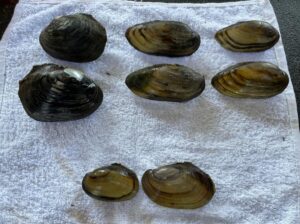On Aug. 9, City environmental consultant Stantec wrapped up a weeklong study and relocation of mussel species inhabiting the waters of the Caney River near the Tuxedo Bridge.
“The study found more than 200 mussels in the survey area,” said Micah Siemers, director of engineering. “While the researchers are still finalizing data, they estimate 13 different species of native mussels were identified; however, no protected species were found.”
Endangered mussel species that had the potential to be present at the site included the Neosho Mucket, Western Fan Shell and the Rabbits Foot.
“All collected mussels were relocated to an approved site with similar water quality and substrate, which was approximately 260 meters upstream of the project site. Each mussel was even carefully placed, right-side-up, in their new habitat,” Siemers said.
The bridge has been limited to one lane for westbound traffic since January 2023, when a pothole in the inside lane required temporary repair. Voters had already approved a $1.2 million bridge rehabilitation during the 2020 General Obligation bond election, so repairs were postponed until the rehab project moved forward.
However, in preparation for the project, environmental studies revealed the possible presence of federally-protected bat and mussel species on or under the bridge which could be impacted during construction.
 Stantec coordinated its approved freshwater mussel survey and relocation plan with the U.S. Army Corps of Engineers (USACE), U.S. Fish and Wildlife Service (USFWS) and the Oklahoma Department of Wildlife Conservation (ODWC).
Stantec coordinated its approved freshwater mussel survey and relocation plan with the U.S. Army Corps of Engineers (USACE), U.S. Fish and Wildlife Service (USFWS) and the Oklahoma Department of Wildlife Conservation (ODWC).
The bridge project is also located within the range of two protected bat species — Northern Long Eared Bat and Tri-Color Bat — which could roost on the underside of the bridge. Due to this, construction of the bridge deck will take place outside of the annual active season for those species.
The bridge rehabilitation project is currently out for bid and anticipated to be awarded at the Sept. 3 City Council meeting. Construction on the project could begin in early fall.
